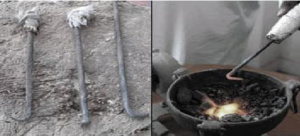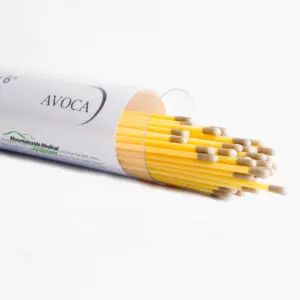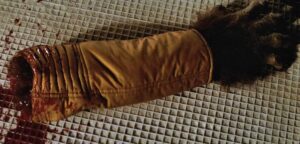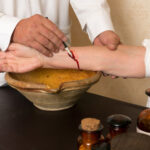Fire Medicine: 9 Key Steps of Wound Cauterization

Rambo uses gun powder and a burning stick to cauterize his AK-47 wound
Along with direct pressure, cauterization (sealing a bleeding wound with fire) is among the very first trauma medical procedures ever developed. Early man’s desperation while watching a loved one bleed out led to the types of common practices we use today.
Clamping a hand over the wound and poking a burning stick into it to see if that would help is obviously coming from a place of extreme desperation and fear.
Cauterization, a medical procedure with origins as old as time, involves the application of heat or chemicals to a wound or incision to stop bleeding and prevent infection.
Unlike other dubious early medical procedures like trepanation, bloodletting, and phrenology, cauterization remains a valuable and occasionally necessary technique in modern medicine.
- Phrenology
- Bloodletting
- Trepanation
“Healers around the world successfully practice traditional cautery (in Arabic kaiy) since ancient times. Traditional cautery, centuries of medical practice with unidentified exact origin has survived till today that authenticates its significance and effectiveness in mitigating human sufferings and diseases.’
‘The historical practice of traditional cautery is documented in diverse ancient cultures but the earliest references found in Surgical Papyrus (1550BC).” Semanticscholar.org

When Is Cauterization Necessary?
- Severe Hemorrhage: Often used in situations where severe, life-threatening bleeding can't be controlled through traditional means. This might occur in surgical settings, accidents, or emergency trauma situations. Tourniquets and wound packing are obviously the better choices in an emergency, but you may not have that crucial gear available.
- Wound Debridement: Cauterization is employed to remove dead or infected tissue, a process known as debridement. It helps prevent the spread of infection and promotes the healing of the surrounding healthy tissue.
- Skin Lesions and Tumors: In dermatology, it’s used to remove skin lesions or benign tumors. By cauterizing the affected tissue, doctors can reduce scarring and minimize the risk of recurrence.
- Elective Procedures: May also be used in elective procedures, such as vasectomy, where sealing the vas deferens prevents sperm from reaching the semen.

Steps for Cauterizing a Wound
Stop! This should only be performed by trained medical professionals, as it carries risks of infection and tissue damage.
However, learning how to do a thing might come in handy someday, so here’s an overview of the general steps involved:
- Assessment and Preparation: Before the procedure, the medical professional assesses the wound, identifies the source of bleeding or the area requiring treatment, and discusses the task with the patient to obtain informed consent.
- Anesthesia: In many cases, local anesthesia is administered to numb the area around the wound. This ensures that the patient experiences minimal pain during the procedure. Without this, life is going to be rough, but you might not have another option.
- Selecting the Method: The medical professional chooses the appropriate method, which may involve heat, electricity, or chemicals, based on the nature of the wound and the desired outcome.
- Sterilization: The equipment, including the device or tool, is sterilized to prevent infection. Sterile conditions are maintained throughout the procedure.
- Controlled Technique: The medical professional cautiously applies the selected method to the target area. This may involve a cautery pen, hot metal, an electrical current, or a chemical agent. The controlled application stops bleeding or removes tissue.
- Monitoring: During the procedure, the medical professional monitors the patient's vital signs, looking for any signs of discomfort or complications. For obvious reasons, you can expect a significant amount of discomfort…
- Careful Tissue Management: If the procedure involves debridement, the medical professional must carefully manage the removal of dead or infected tissue, taking care not to damage healthy tissue.
- Wound Management: The wound is cleaned, dressed, and bandaged to prevent infection and promote healing.
- Patient Care and Follow-up: The patient is closely monitored during recovery to ensure there are no complications or signs of infection.

Silver Nitrate Sticks are often used as a chemical applicator for wound cauterization.
Risks and Considerations
Cauterization, while an effective technique, carries several risks and considerations:
- Tissue Damage: Overcauterization can lead to excessive tissue damage and complications, including delayed wound healing and scarring.
- Infection: This is a constant threat to every patient, even in this modern world. In an everyday hospital, patients will be immediately hooked up to high-strength and targeted antibiotics to combat the enormous risk of infection. Inadequate sterilization or post-procedural care can result in wound infections, which may require further treatment.
- Pain and Discomfort: Despite local anesthesia, cauterization can, and probably will, cause some discomfort or pain during and after the procedure.
- Burns: Cauterization methods using heat can lead to burns, which must be properly managed to avoid complications.
- Alternative Treatments: Medical professionals consider cauterization as a last resort when other methods of wound control or tissue removal are inadequate.

Lightsabers cauterize wounds instantaneously…
Doc’s Wrap Up
Cauterization is a time-honored medical technique that remains relevant in modern medicine for managing severe bleeding, removing tissue, and certain elective procedures. It should only be performed by trained medical professionals to ensure safety and efficacy.
Understanding the necessity of cauterization in specific medical situations, along with the steps and considerations involved, is essential for both healthcare providers and patients.
When applied in the right circumstances, it can be a valuable tool in ensuring patient well-being and preventing further complications.



